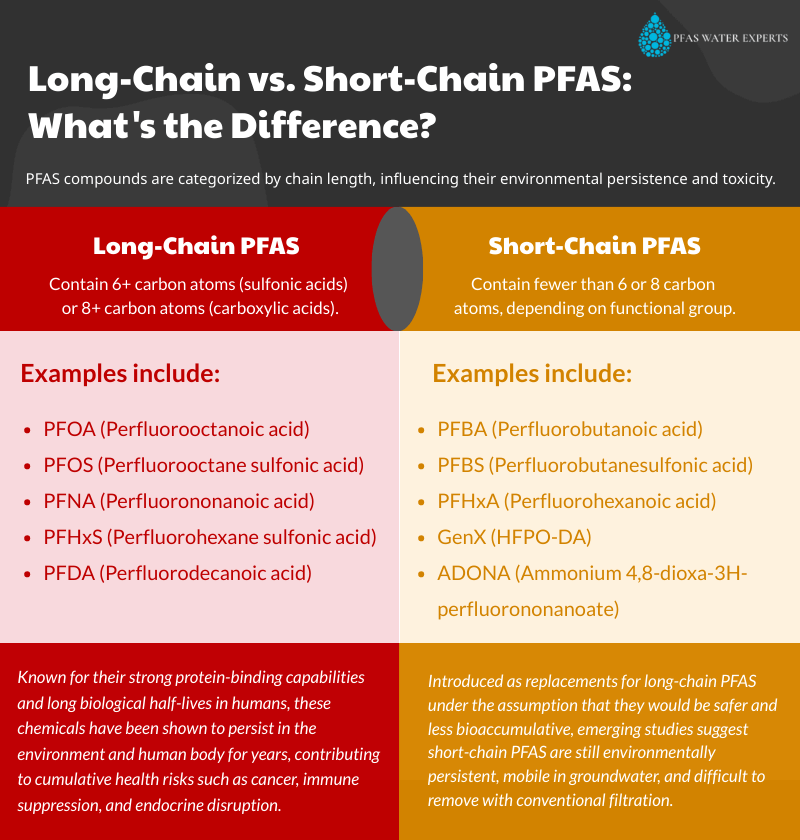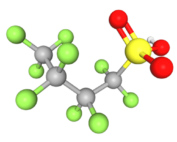Introduction
PFNA, or perfluorononanoic acid, is a long-chain perfluoroalkyl carboxylic acid composed of nine carbon atoms. While it belongs to the broader class of PFAS chemicals, PFNA exhibits unique properties that distinguish it from its more widely known relatives, such as PFOA and PFOS.
PFNA is extremely persistent in the environment and the human body, raising alarms for both scientists and public health officials. As regulatory bodies ramp up scrutiny, PFNA continues to be detected in drinking water, groundwater, and food sources across the country.
This article explores what PFNA is, how it was used, where people are likely to encounter it, and the latest science on its health effects—including peer-reviewed citations.
What is PFNA and Why Was It Used?
PFNA is a long-chain perfluoroalkyl carboxylic acid with nine carbon atoms. It was originally developed for use in:
- Fluoropolymer production, including nonstick and chemical-resistant coatings
- Water- and oil-repellent textiles and paper products
- Firefighting foams (AFFF) used on military bases and airports
- Industrial surfactants and emulsifiers in electronics and metal plating
Its appeal came from its chemical stability, but that same quality has made it a threat: PFNA does not break down in the environment and has been found in the blood of both exposed workers and the general population.

Where Is PFNA Found?
PFNA has been found in:
- Public water systems, particularly in New Jersey, Delaware, Michigan, and California — notably in towns like Paulsboro, NJ; Oscoda, MI (near former Wurtsmith Air Force Base); and Benicia, CA, where industrial facilities or firefighting training have contributed to groundwater contamination.
- Soil and sediment near fluorochemical manufacturing plants such as those formerly operated by DuPont and Solvay Specialty Polymers in New Jersey, and 3M facilities in Minnesota. In Paulsboro, New Jersey, Solvay Specialty Polymers and DuPont facilities released PFNA into local waterways, contaminating drinking water supplies for tens of thousands of residents.
- Groundwater downstream from AFFF firefighting training sites and on US military bases — including Wurtsmith AFB (MI), Pease AFB (NH), and Naval Air Station Joint Reserve Base Willow Grove (PA)—where PFNA has been detected in both on-base and off-base water wells.
- Fish and agricultural products in contaminated regions, including PFNA-tainted fish caught in the Delaware River and produce grown in hotspot areas irrigated with contaminated groundwater like in Paulsboro, NJ.
- Household items treated with PFAS-containing materials such as stain-resistant carpets, waterproof clothing, nonstick cookware, and even certain electronics can release PFAS into the air and onto surfaces in your home. A 2019 study published in Environmental Science & Technology found that PFNA and related PFAS were commonly detected in household dust collected from residences near contaminated water sources.
What Does the Science Say About PFNA’s Health Effects?
Scientific research on PFNA has significantly expanded over the past decade, reinforcing concerns about its potential to harm multiple biological systems.
Here’s what the peer-reviewed literature currently tells us:
Bioaccumulation and Persistence
- PFNA has one of the longest biological half-lives among PFAS chemicals—estimated at 4.3 years in the human body. Unlike shorter-chain PFAS, PFNA binds tightly to serum proteins and accumulates in liver, kidney, and fetal tissue.
- This prolonged retention magnifies its toxicological impact, especially in communities with chronic or repeated exposures through contaminated water or diet.
Developmental & Neurological Effects
- Studies confirm PFNA crosses the placenta, with fetal-to-maternal plasma concentration ratios approaching 1:1. This highlights PFNA’s strong placental transfer efficiency, raising concerns about prenatal toxicity.
- Elevated PFNA levels during pregnancy have been associated with intrauterine growth restriction (IUGR), altered testosterone and estrogen levels, and disrupted IGF (insulin-like growth factor) signaling—all critical for fetal organ development.
- A separate 2018 study in Environmental Research also linked PFNA levels in mothers to cognitive and behavioral delays in children.
Liver Damage & Cholesterol Increases
- PFNA exposure has been linked to nonalcoholic fatty liver disease (NAFLD), lipid imbalances, and hepatic enlargement. In human biomonitoring studies, PFNA positively correlates with elevated ALT and GGT liver enzymes, which indicate liver cell stress and potential inflammation.
- It also raises total and LDL cholesterol levels in exposed individuals, as documented in a 2016 Environmental Health Perspectives study.
Immune System Suppression
- The National Toxicology Program cited robust evidence from animal studies showing PFNA causes thymus atrophy, reduced lymphocyte counts, and weakened T-cell-dependent antibody responses.
- In human epidemiological studies, higher serum PFNA levels were correlated with poorer vaccine responses in children and altered cytokine expression—including suppression of IL-2 and IFN-γ, which play vital roles in antiviral immunity.
Endocrine and Thyroid Disruption
- PFNA interferes with thyroid hormone transport and metabolism. It competes with thyroxine (T4) for binding sites on transthyretin (TTR), potentially reducing circulating thyroid hormone availability.
- Multiple cohort studies show PFNA exposure is associated with increased TSH and decreased free T4 levels, indicative of subclinical hypothyroidism, especially during gestation and early childhood.
Potential Cancer Risk
- Though more human research is needed, PFNA’s structure and behavior mirror those of known carcinogens like PFOA. Although PFNA is not officially classified as a human carcinogen, toxicology studies show that it induces peroxisome proliferation, hepatocellular hypertrophy, and increased liver tumor incidence in rodents.
- Structurally, PFNA shares strong homology with PFOA—a PFAS linked to kidney, liver, and testicular cancers. Animal studies suggest PFNA may act as a promoter in multi-stage carcinogenesis, particularly in the liver and endocrine-related tissues.
- PFNA activates PPARα pathways, which have been associated with liver cancer and pancreatic tumors in animal studies. Rodent models demonstrate dose-dependent increases in liver weight, hepatocyte swelling, and enzyme dysregulation, suggesting hepatotoxicity via PPARα-mediated mechanisms.
What Are Regulators Doing About It?
- The New Jersey Department of Environmental Protection was the first state to set a drinking water standard (MCL) for PFNA at 13 parts per trillion (ppt).
- The EPA’s 2023 proposed national standards include PFNA in a hazard index approach to regulate combined PFAS toxicity.
- Several other states, including Michigan and California, have issued guidance values or interim action levels.
Despite these developments, most U.S. residents remain untested and unprotected from PFNA exposure.
How Can You Protect Yourself?
✅ Get your water tested, especially if you live near a known contamination site.
✅ Install a certified water filter (NSF/ANSI 53 or 58) that targets PFAS, including PFNA.
✅ Avoid stain-resistant fabrics, nonstick cookware, and grease-resistant packaging.
✅ Support PFAS legislation and cleanup funding in your state.
✅ Request PFAS blood testing from your physician if you believe you’ve been exposed.
Conclusion
As a long-chain PFAS, PFNA is a potent and enduring chemical threat with mounting scientific evidence linking it to serious health consequences. From impaired immunity to developmental delays and potential cancer risks, PFNA’s reach extends far beyond the communities where it was manufactured.
Its presence in water, food, and everyday products—and its persistence in the human body—make inaction a dangerous gamble. The lack of consistent federal regulation only compounds the problem, leaving many Americans unknowingly exposed.
Now is the time for action. Communities must demand stronger protections, healthcare providers must advocate for routine PFAS screening, and lawmakers must move swiftly to close regulatory gaps.
Written By:
PFAS Water Experts
Science and Editorial Content Team
Our team is made up of physicians, scientific researchers, epidemiologists and environmental toxicologists with extensive experience and knowledge pertaining to PFAS and their effects on animal and human health.
SCIENTIFIC REVIEW BY:

Dr. Francis Okejiri
Scientific Reviewer
Dr. Francis Okejiri is a scientific author and reviewer at PFAS Water Experts. He holds a PhD in chemistry with a focus in analytical and environmental science. He has authored over 17 peer-reviewed publications and brings broad experience in evaluating contaminants and complex environmental data.




